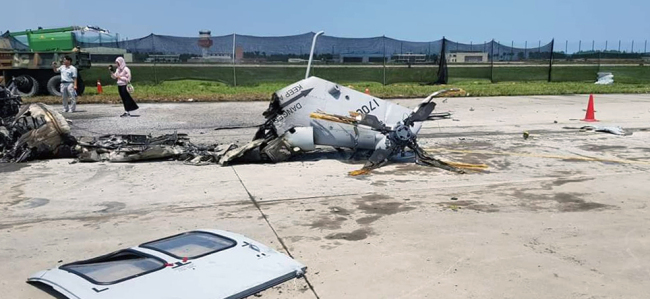Mechanical defect may be to blame for marine chopper crash: experts
By Yeo Jun-sukPublished : July 19, 2018 - 16:32
Tuesday’s Marine chopper crash might have been caused by mechanical defects in the latest deployed helicopter, military officials and experts said, as investigation into the fatal accident that killed five Marines and injured one continues.
The MUH-1 Marineone crashed at a Marine base in the southeastern city of Pohang, North Gyeongsang Province, killing five of the six Marines aboard and injuring the other. The helicopter caught fire after plunging to the landing strip from about 10 meters in the air.
Given that the pilot was a veteran with around 3,300 hours of flight experience, military officials and experts suspect there may have been mechanical defects in the Marineone, a Marine variant of the 90 KUH-1 Surion helicopter used by the Army.
“Since the Surion helicopters were deployed in 2012, there have been different types of accidents and defects. ... But we have never seen the rotor blade being completely separated from the body,” said a military official, requesting anonymity due to sensitivity of the issue.
The MUH-1 Marineone crashed at a Marine base in the southeastern city of Pohang, North Gyeongsang Province, killing five of the six Marines aboard and injuring the other. The helicopter caught fire after plunging to the landing strip from about 10 meters in the air.
Given that the pilot was a veteran with around 3,300 hours of flight experience, military officials and experts suspect there may have been mechanical defects in the Marineone, a Marine variant of the 90 KUH-1 Surion helicopter used by the Army.
“Since the Surion helicopters were deployed in 2012, there have been different types of accidents and defects. ... But we have never seen the rotor blade being completely separated from the body,” said a military official, requesting anonymity due to sensitivity of the issue.

Closed-circuit television footage released by the Marines shows the helicopter’s rotor blade becoming separated from the fuselage after takeoff, just four to five seconds after flying 10 meters above the ground.
The rotor blade was found about 20 meters away from the fuselage, which burned down after the crash. The main rotor was not damaged by the fire, but one of its four blades was separated from the body.
Some experts have suggested that the accident could be attributed to the lack of efforts to fix the defects found in Marineone’s original model Surion, which suffered from various defects and raised concerns over flight safety.
“I suspect that technical defects occurred when the military modified Surion to develop its marine variant,” said Lee Il-Woo, a military analyst at Seoul-based Korea Defence Network. “It only took one year and six months to develop Marineone.”
The Board of Audit and Inspection deemed last year that Surion helicopters were not airworthy as they lacked lightning protection and anti-icing capability. The agency even requested a probe into the country’s arms procurement agency.
After being suspended from operational deployment, the helicopter recently passed de-icing tests. The Defense Acquisition Program Administration said in June that the chopper proved its capability to fly in minus 30 degrees Celsius for at least 30 minutes without ice forming on the inside.
Cheong Wa Dae, meanwhile, played down concerns over the Surion, saying the chopper has passed safety tests and retains “world-class” capability. The multirole Surion chopper was produced by Korea’s sole aircraft manufacturer Korea Aerospace Industries.
“Just because Marineone is a variant of Surion, and Surion had suffered from mechanical defects, speculation can emerge that (the current) Surion helicopter appears to have a significant problem,” a Cheong Wa Dae official told reporters Wednesday under the customary condition of anonymity.
“But the icing problem, raised by the Board of Audit and Inspection, was completely solved. Surion is a world-class chopper with excellent capability. That is what we discussed and the Defense Ministry needs to explain that to the public.”
South Korea invested about 1.3 trillion won ($1.15 billion) from June 2006 for KAI to develop the Surion, and the project was completed in July 2012 after it was approved for combat use. Since then, the South Korean military has deployed 60 Surions in the field.
By Yeo Jun-suk (jasonyeo@heraldcorp.com)

















![[KH Explains] Hyundai's full hybrid edge to pay off amid slow transition to pure EVs](http://res.heraldm.com/phpwas/restmb_idxmake.php?idx=652&simg=/content/image/2024/04/18/20240418050645_0.jpg&u=20240419100350)

